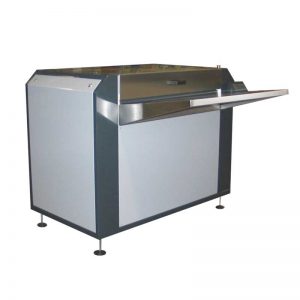What is the point?
In a recent BLOG, reference was made to some flexographic printers using the patented Clean Plate Technology experienced such great ink transfer from plate to the substrate it often leaves the plate looking clean after the press run. Therefore, some have asked the question, "If Clean Plate Technology is so effective, why would anyone invest in an automatic plate cleaner (APC)?" Let's take a step back and quickly address what is Clean Plate Technology?
Clean Plate Technology Defined
Developers of the Clean Plate Technology, MacDermid Graphics Solutions, describes the product as Patented Clean Plate Technology improving plate cleanliness on press. Clean Plate Technology not only reduces ink build-up in-between dots and reverses, but it also makes the plate easier to clean when cleaning is required. The result is beneficial in plate efficiency, allowing for longer run lengths without cleaning. The reduction in ink build-up allows for smoother vignettes with less tendency for ink to print that has accumulated on the sidewalls of dots providing for smoother tonal gradations and a more aesthetically pleasing print result.
Automatic Plate Cleaners (APCs)
Automatic plate cleaners were designed not only to effectively deep clean plates in the smallest plate relief areas including high LPI screens, but they also offer a much more consistent "hands-free" result. Not unlike the plate processors that washout out the relief between images and dots during the manufacturing of the plate, soft bristles scrub deep into the relief areas of the plate using solutions that are compatible with solvent, UV, and water-based inks. The result is a plate that has been returned to its original condition in regards to cleanliness and original open relief.
Considering it is so important to clean expensive photopolymer plates immediately after the press run, why doesn't it always happen in this fashion? A simple fact is that some people just don't like to do it... me included. Some individuals claim that the repetitive scrubbing motion gives them pain in their hands and wrist. This repetitive motion can cause muscles and tendons in the hands and wrists to tighten up and lead to carpal tunnel syndrome, and other forms of repetitive stress injury (RSI). But beyond just not wanting to clean plates, the people cleaning plates are often the same people focusing on getting the press set up for the next production order. So even though we say we want the plates cleaned immediately, we may not be willing to enforce this if it has a negative impact on press uptime, so plates often get put by the wayside. Because the operator is not required to babysit the plate washer, it is much easier to get plates cleaner and faster following a press run.
So circling back around to the original question; "If Clean Plate Technology is so effective, why would anyone invest in an APC?"
Here's Your Answer

Clean Plate Technology improves plate life by reducing the physical cleaning requirement that ultimately impacts plate integrity regardless of how the cleaning is conducted. However, keep in mind that each production job goes through a press set-up in which anilox to plate settings are adjusted and operators often hand wipe the plate and smear ink into the fine screen relief areas. These normal actions are often not significant enough to affect the printed product throughout the press run, but if left remaining on the photopolymer plate as it is filed away into storage can have a significant effect on the plate durometer (hardness), plate drape, and the life of the plate. In short, if you combine proper use of an APC with photopolymer plates formulated with Clean Plate Technology, you are greatly improving your ability to maximize plate life and performance.
If you want to learn more about this subject, please feel free to reach out to us by calling 1-800-445-4017, or by e-mail at [email protected].
All Printing Resources has formed our Technical Solutions Group (TSG) to encompass our full range of expertise in all critical areas of the flexo process. This team is made up of industry professionals dedicated to being up-to-date on new technologies along with best practices. They are armed with the latest in diagnostic tools and are experienced in problem-solving that can achieve sustainable results. The TSG has walked in your shoes, and have felt your pain.
